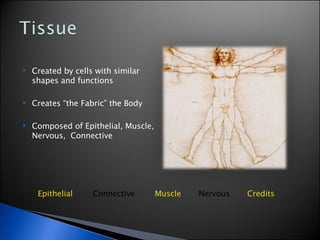Science Jeff Lee
- 1. Created by cells with similar shapes and functions Creates âthe Fabricâ the Body Composed of Epithelial, Muscle, Nervous, Connective Epithelial Connective Muscle Nervous Credits
- 2. Almost entirely composed of cells Can be divided into Simple and Stratified Epithelium Classified by the number of cell layers and the cell shape Home Simple Epithelium Stratified Epithelium
- 3. Consists of single-celled layers Main functions consist of absorption and filtration Has three primary shapes Home Simple Squamous Simple Cuboidal Simple Columnar Psuedostratified Columnar Courtesy of akay
- 4. Contain a sparse cytoplasm They consist of single flattened cells Specialize in diffusion and filtration Divided into two sections Home Simple Cuboidal Simple Columnar Psuedostratified Columnar Mesothelium Endothelium Courtesy of pbchua
- 5. Consists of a cube-like shape Contain one large spherical central nuclei Primary functions include secretion and absorption Home Simple Squamous Simple Columnar Psuedostratified Columnar
- 6. Creates a slick, friction reducing lining Found in hollow organs of cardiovascular system Allows the exchanges between blood streams and tissue cells Home Mesothelium Courtesy of Partlynch
- 7. Found in the serous membrane Lines the ventral cavity Covers organs Home Endothelium
- 8. Contains closely packed cells Located in areas of the digestive tract Associated mostly with absorption and secretion Home Simple Squamous Simple Cuboidal Psuedostratified Columnar Courtesy of Christiâs Photos
- 9. Looks as if many cell layers are present May or may not contain cilia and goblet cells Location depends on characteristics Home Simple Squamous Simple Cuboidal Simple Columnar Courtesy of Ra5my
- 10. Have two more cell layers Main concerns include protection Identified by apical layer Home Stratified Squamous Stratified Cuboidal Stratified Columnar Transitional
- 11. Most commonly found of all stratified epithelia Main functions include protection May or may not contain keratin Home Stratified Cuboidal Stratified Columnar Transitional
- 12. It is rare to find in the body Found in the ducts of larger glands Consists of only two layers Home Stratified Squamous Stratified Columnar Transitional
- 13. Not commonly found in the body It is located in smalls amounts in specific areas of the body Usually found in junctions of two other types of epithelium Home Stratified Squamous Stratified Cuboidal Transitional
- 14. They have the ability to alter their shape Basal cells are cuboidal or columnar Apical layer consists of domelike or squamous shaped cells Home Stratified Squamous Stratified Cuboidal Stratified Columnar
- 15. They are highly cellular Responsible for much of bodyâs movement Three different types Home Skeletal Muscle Cardiac Muscle Smooth Muscle
- 16. Attach to bones of the skeleton Forms the bodyâs flesh Allows the body to voluntarily create movement Home Cardiac Muscle Smooth Muscle
- 17. Found only in the walls of the heart Creates intercalated discs Aids in propelling blood throughout the entire body Home Skeletal Muscle Smooth Muscle
















